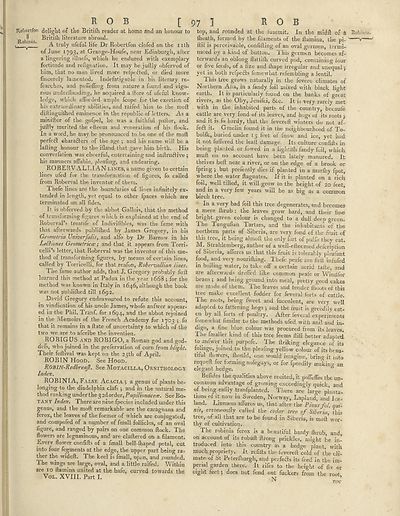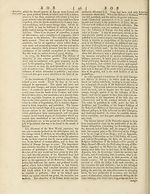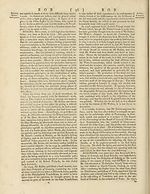Encyclopaedia Britannica, or, a Dictionary of arts, sciences, and miscellaneous literature : enlarged and improved. Illustrated with nearly six hundred engravings > Volume 18, RHI-SCR
(105) Page 97
Download files
Complete book:
Individual page:
Thumbnail gallery: Grid view | List view

ROB [
Robertfon delig’nt of tlie Britifh reader at home and an honour to
11 . Britilh literature abroad.
, , °A truly iifeful life Dr Robertfon clofed on the nth
of June 1793, at Grange-Houfe, near Edinburgh, after
a lingering illnefs, which he endured with exemplary
fortitude and refignation. It may be jullly obferved of
him, that no man lived more rel'pefted, or died more
fmcerely lamented. Indefatigable in his literary re-
fearches, and poffefling from nature a found and vigo-
r<ms underftanding, he acquired a (lore of ufeful know¬
ledge, which afforded ample fcope for the exertion of
his extraordinary abilities, and raifed him to the moft
diftinguifhed eminence in the republic of letters. As a
minilfer of the gofpel, he was a faithful pallor, and
juflly merited the efleem and veneration of his flock.
In a word, he may be pronounced to be one of the mod
perfefl characters of the age •, and his name will be a
lading honour to the ifland that gave him birth. His
converfation was cheerful, entertaining and indrudive ;
his manners affable, pleaflng, and endearing.
ROBER V AL LIAN lines, a name given to certain
lines ufed for the transformation of figures, fo called
from Roberval the inventor of them.
Thefe lines are the boundaries of lines infinitely ex¬
tended in length, yet equal to other fpaces which are
terminated on all fides.
It is obferved by the abbot Gallois, that the method
of transforming figures which is explained at the end of
Roberval’s treatife of Indivifibles, was the fame with
that afterwards publifhed by James Gregory, in his
Geometria Univerfa/is, and alfo by Dr Barrow in his
Leftiones Geometricce; and that it appears from Torri¬
celli’s letter, that Roberval was the inventor of this me¬
thod of transforming figures, by means of certain lines,
called by Torricelli, for that reafon, Roberva/lian lines.
The fame author adds, that J. Gregory probably fird
learned this method at Padua in the year 1668 ; for the
method was known in Italy in 1646, although the book
was not publifhed till 1692.
David Gregory endeavoured to refute this account,
in vindication of his uncle James, whofe anfvver appear¬
ed iir the Phil. Tranf. for 1694, and the abbot rejoined
in the Memoirs of the French Academy for 1703 ; fo
that it remains in a date of uncertainty to which of the
two we are to aferibe the invention.
ROBIGUS AND ROBIGO, a Roman god and god-
defs, who joined in the prefervation of corn from blight.
Their fedival was kept on the 25th of April.
ROBIN Hood. See Hood.
R OB IN- R edbreajl. See MoTACILLA, ORNITHOLOGY
Index.
ROBINIA, False Acacia *, a genus of plants be¬
longing to the diadelphia clafs j and in the natural me¬
thod ranking under the 3 2d order, Papilionacece. See Bo¬
tany Index. There are nine fpecies included under this
genus, and the mod remarkable are the caragnana and
ferox, the leaves of the former of which are conjugated,
and compofed of a number of fmall follicles, of an oval
figure, and ranged by pairs on one common dock. The
flowers are leguminous, and are cludered on a filament.
Every flower confids of a fmall belbfhaped petal, cut
into four fegments at the edge, the upper part being ra¬
ther the wided. I he keel is fmall, open, and rounded.
The wings are large, oval, and a little raifed. Within
are 10 (lamina united at the bafe, curved towards the
Vol. XVIII. Part I.
97 ] ROB
top, and rounded at the iummit. In the midfl of 1 Robinia.
(heath, formed by the filaments of the damina, the pi-
itii is perceivaole, confiding of an oval germen, termi¬
nated by a kind of button, i his gernitn becomes af¬
terwards an oblong flattifli curved pod, containing lour
or five (eeds, of a iize and lhape irregular and unequal j
yet in both reipecls fomewhat refembiing a lentil.
This tree grows naturally in the fevere climates of
Northern Alia, in a fandy foil mixed with black light
earth. It is particularly found on the banks of great
rivers, as the Oby, Jenilei, &c. It is very rarely met
with in the inhabited parts of the country, becaufe
cattle are very fond of its leaves, and hogs of its roots >
and it is fo hardy, that the fevered winters do not af-
fe£l it. Gmelin found it in the neighbourhood of To-
buried under 15 feet of fnow and ice, yet had
it not (uttered the lead damage. Its culture confids in
being planted or lowed in a lightifli fandy foil, which
mud on no account have been lately manured. It
thrives bed near a river, or on the edge of a brook or
fpring j but prefently dies if planted in a marfliy fpot,
where the water dagnates. If it is planted on a rich
foil, well tilled, it Mull grow to the height of 20 feet,
and in a very few years will be as big as a common
birch tree.
In a very bad foil this tree degenerates, and becomes
a mere (hrub ; the leaves grow hard, and their fine
bright green colour is changed to a dull deep green.
The Tungufian Tartars, and the inhabitants of the
northern parts of Siberia, are very fond of the fruit of
this tree, it being almod the only fort of pulib they eat.
M. Strahlemberg, author of a well-edeemed defeription
of Siberia, affures us that this fruit is tolerably pleafant
food, and very nourifhing. Thefe peafe are fird infufed
in boiling water, to take off a certain acrid tade, and
are afterwards dreffed like common peafe or Windfor
beans; and being ground into meal, pretty good cakes
are made of them, i he leaves and tender (hoots of this
tree make excellent fodder for feveral forts of cattle.
The roots, being fweet and fuceulent, are very well
adapted to fattening hogs ; and the fruit is greedily eat¬
en by all lorts of poultry. After levelal experiments
fomewhat fimilar to the methods ufed with anil and in¬
digo, a fine blue colour was procured from its leaves.
The fmaller kind of this tree feems dill better adapted
to anfwer this purpofe. The driking elegance of its
foliage, joined to the pleafing yellow colour of its beau-
ti(ul flowers, (hould, one would imagine, bring it into
requefl for forming nofegays, or for fpeedily making an
elegant hedge. 0
Befides the qualities above recited, it poffeffes the un¬
common advantage of growing exceedingly quick, and
of being eaiily tranfplanted. There are large planta¬
tions of it now in Sweden, Norway, Lapland, and Ice¬
land. Linnaeus affures us, that after the Finns fol. qui¬
nts, erroneoufly called the cedar tree of Siberia, this
tree, of ail that are to be found in Siberia, is mod wor¬
thy of cultivation.
The robinia ferox is a beautiful hardy (hrub, and,
on account of its robud drong prickles, might be in¬
troduced into this country as a hedge plant, with
much propriety. It refids the fevered cold of the cli¬
mate of St Peterfburgh, and perfe&s its feed in the im¬
perial garden there. It rifes to the height of fix or
eight feet; does not fend out fuckers from the root,
Robertfon delig’nt of tlie Britifh reader at home and an honour to
11 . Britilh literature abroad.
, , °A truly iifeful life Dr Robertfon clofed on the nth
of June 1793, at Grange-Houfe, near Edinburgh, after
a lingering illnefs, which he endured with exemplary
fortitude and refignation. It may be jullly obferved of
him, that no man lived more rel'pefted, or died more
fmcerely lamented. Indefatigable in his literary re-
fearches, and poffefling from nature a found and vigo-
r<ms underftanding, he acquired a (lore of ufeful know¬
ledge, which afforded ample fcope for the exertion of
his extraordinary abilities, and raifed him to the moft
diftinguifhed eminence in the republic of letters. As a
minilfer of the gofpel, he was a faithful pallor, and
juflly merited the efleem and veneration of his flock.
In a word, he may be pronounced to be one of the mod
perfefl characters of the age •, and his name will be a
lading honour to the ifland that gave him birth. His
converfation was cheerful, entertaining and indrudive ;
his manners affable, pleaflng, and endearing.
ROBER V AL LIAN lines, a name given to certain
lines ufed for the transformation of figures, fo called
from Roberval the inventor of them.
Thefe lines are the boundaries of lines infinitely ex¬
tended in length, yet equal to other fpaces which are
terminated on all fides.
It is obferved by the abbot Gallois, that the method
of transforming figures which is explained at the end of
Roberval’s treatife of Indivifibles, was the fame with
that afterwards publifhed by James Gregory, in his
Geometria Univerfa/is, and alfo by Dr Barrow in his
Leftiones Geometricce; and that it appears from Torri¬
celli’s letter, that Roberval was the inventor of this me¬
thod of transforming figures, by means of certain lines,
called by Torricelli, for that reafon, Roberva/lian lines.
The fame author adds, that J. Gregory probably fird
learned this method at Padua in the year 1668 ; for the
method was known in Italy in 1646, although the book
was not publifhed till 1692.
David Gregory endeavoured to refute this account,
in vindication of his uncle James, whofe anfvver appear¬
ed iir the Phil. Tranf. for 1694, and the abbot rejoined
in the Memoirs of the French Academy for 1703 ; fo
that it remains in a date of uncertainty to which of the
two we are to aferibe the invention.
ROBIGUS AND ROBIGO, a Roman god and god-
defs, who joined in the prefervation of corn from blight.
Their fedival was kept on the 25th of April.
ROBIN Hood. See Hood.
R OB IN- R edbreajl. See MoTACILLA, ORNITHOLOGY
Index.
ROBINIA, False Acacia *, a genus of plants be¬
longing to the diadelphia clafs j and in the natural me¬
thod ranking under the 3 2d order, Papilionacece. See Bo¬
tany Index. There are nine fpecies included under this
genus, and the mod remarkable are the caragnana and
ferox, the leaves of the former of which are conjugated,
and compofed of a number of fmall follicles, of an oval
figure, and ranged by pairs on one common dock. The
flowers are leguminous, and are cludered on a filament.
Every flower confids of a fmall belbfhaped petal, cut
into four fegments at the edge, the upper part being ra¬
ther the wided. I he keel is fmall, open, and rounded.
The wings are large, oval, and a little raifed. Within
are 10 (lamina united at the bafe, curved towards the
Vol. XVIII. Part I.
97 ] ROB
top, and rounded at the iummit. In the midfl of 1 Robinia.
(heath, formed by the filaments of the damina, the pi-
itii is perceivaole, confiding of an oval germen, termi¬
nated by a kind of button, i his gernitn becomes af¬
terwards an oblong flattifli curved pod, containing lour
or five (eeds, of a iize and lhape irregular and unequal j
yet in both reipecls fomewhat refembiing a lentil.
This tree grows naturally in the fevere climates of
Northern Alia, in a fandy foil mixed with black light
earth. It is particularly found on the banks of great
rivers, as the Oby, Jenilei, &c. It is very rarely met
with in the inhabited parts of the country, becaufe
cattle are very fond of its leaves, and hogs of its roots >
and it is fo hardy, that the fevered winters do not af-
fe£l it. Gmelin found it in the neighbourhood of To-
buried under 15 feet of fnow and ice, yet had
it not (uttered the lead damage. Its culture confids in
being planted or lowed in a lightifli fandy foil, which
mud on no account have been lately manured. It
thrives bed near a river, or on the edge of a brook or
fpring j but prefently dies if planted in a marfliy fpot,
where the water dagnates. If it is planted on a rich
foil, well tilled, it Mull grow to the height of 20 feet,
and in a very few years will be as big as a common
birch tree.
In a very bad foil this tree degenerates, and becomes
a mere (hrub ; the leaves grow hard, and their fine
bright green colour is changed to a dull deep green.
The Tungufian Tartars, and the inhabitants of the
northern parts of Siberia, are very fond of the fruit of
this tree, it being almod the only fort of pulib they eat.
M. Strahlemberg, author of a well-edeemed defeription
of Siberia, affures us that this fruit is tolerably pleafant
food, and very nourifhing. Thefe peafe are fird infufed
in boiling water, to take off a certain acrid tade, and
are afterwards dreffed like common peafe or Windfor
beans; and being ground into meal, pretty good cakes
are made of them, i he leaves and tender (hoots of this
tree make excellent fodder for feveral forts of cattle.
The roots, being fweet and fuceulent, are very well
adapted to fattening hogs ; and the fruit is greedily eat¬
en by all lorts of poultry. After levelal experiments
fomewhat fimilar to the methods ufed with anil and in¬
digo, a fine blue colour was procured from its leaves.
The fmaller kind of this tree feems dill better adapted
to anfwer this purpofe. The driking elegance of its
foliage, joined to the pleafing yellow colour of its beau-
ti(ul flowers, (hould, one would imagine, bring it into
requefl for forming nofegays, or for fpeedily making an
elegant hedge. 0
Befides the qualities above recited, it poffeffes the un¬
common advantage of growing exceedingly quick, and
of being eaiily tranfplanted. There are large planta¬
tions of it now in Sweden, Norway, Lapland, and Ice¬
land. Linnaeus affures us, that after the Finns fol. qui¬
nts, erroneoufly called the cedar tree of Siberia, this
tree, of ail that are to be found in Siberia, is mod wor¬
thy of cultivation.
The robinia ferox is a beautiful hardy (hrub, and,
on account of its robud drong prickles, might be in¬
troduced into this country as a hedge plant, with
much propriety. It refids the fevered cold of the cli¬
mate of St Peterfburgh, and perfe&s its feed in the im¬
perial garden there. It rifes to the height of fix or
eight feet; does not fend out fuckers from the root,
Set display mode to:
![]() Universal Viewer |
Universal Viewer | ![]() Mirador |
Large image | Transcription
Mirador |
Large image | Transcription
Images and transcriptions on this page, including medium image downloads, may be used under the Creative Commons Attribution 4.0 International Licence unless otherwise stated. ![]()
| Permanent URL | https://digital.nls.uk/193020072 |
|---|
| Attribution and copyright: |
|
|---|
| Description | Ten editions of 'Encyclopaedia Britannica', issued from 1768-1903, in 231 volumes. Originally issued in 100 weekly parts (3 volumes) between 1768 and 1771 by publishers: Colin Macfarquhar and Andrew Bell (Edinburgh); editor: William Smellie: engraver: Andrew Bell. Expanded editions in the 19th century featured more volumes and contributions from leading experts in their fields. Managed and published in Edinburgh up to the 9th edition (25 volumes, from 1875-1889); the 10th edition (1902-1903) re-issued the 9th edition, with 11 supplementary volumes. |
|---|---|
| Additional NLS resources: |
|

